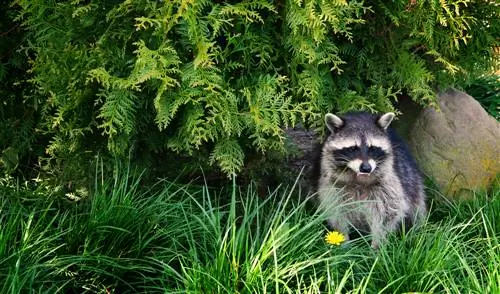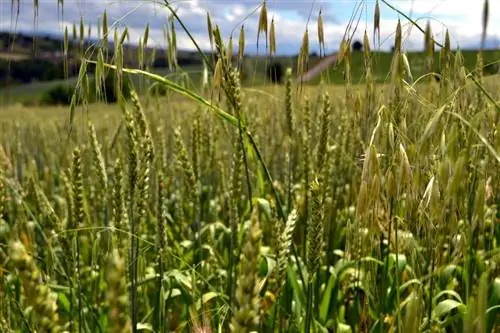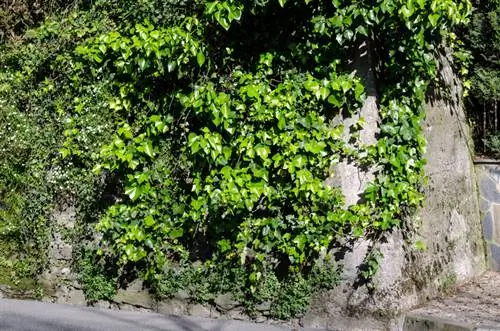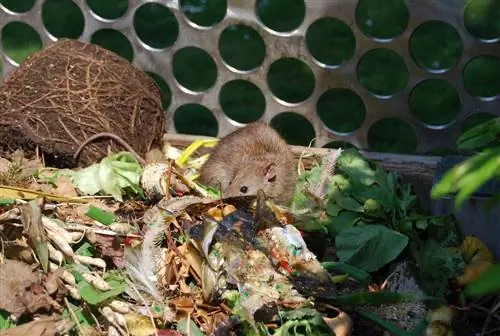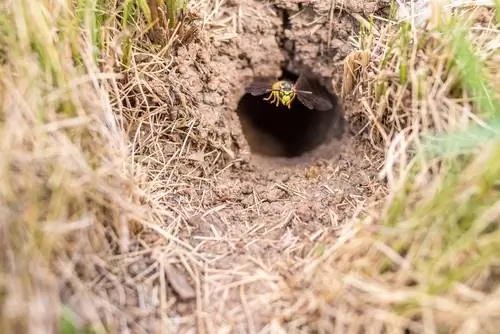- Author admin [email protected].
- Public 2023-12-16 16:46.
- Last modified 2025-01-23 11:22.
In some places, the furry mini bears are considered a real pest because they spread en masse and cause enormous damage. Reason enough to take action against the animals, but capturing or even killing them is prohibited. Those affected can defend themselves with deterrent and preventative measures.
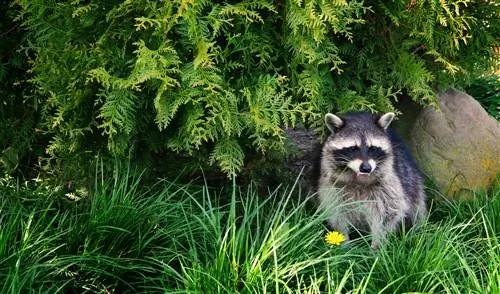
How to effectively get rid of a raccoon?
To drive away a raccoon, you can use regular patrols, bright lights and water. Ultrasound machines and home remedies like chili can also help. Preventive measures such as closing entrances and eliminating food sources are recommended.
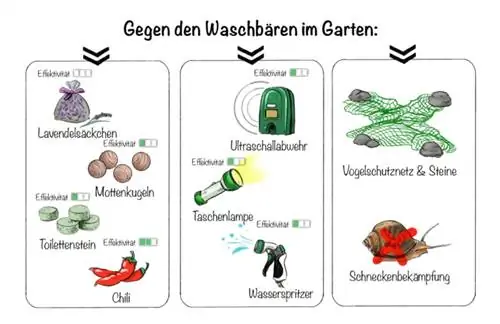
Drive raccoons out of the garden
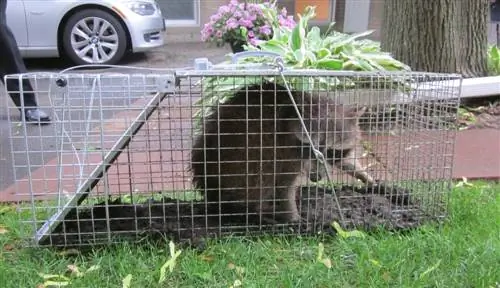
Raccoons must not be caught - not even in live traps
Private individuals are not allowed to specifically fight the raccoon. It is forbidden by law to use live and dead traps. If you violate this law, you run the risk of criminal charges for poaching and animal cruelty. But your own he alth is also at risk. If you corner raccoons, they will react aggressively and can transmit rabies through bites. You should therefore focus on targeted deterrent measures.
Hunters and conservationists agree that the raccoon poses a threat to local biodiversity.
Regular inspections
If you have already spotted a raccoon in your yard, check the property every evening. This way you can catch the unwanted visitor in the act while foraging and he won't be given the feeling that he can feel safe. If daily monitoring is too much effort for you, you will cause disruptions. Raccoons don't like bright light or water.
Annoyance by disruption
If you encounter the animal, shine a flashlight on it. The bright light has a deterrent effect and scares the raccoon away. You can throw pine cones in the direction of the animal without hitting it directly. Water from the garden hose also has a deterrent effect if you spray the raccoon indirectly. A deterrent alternative with an automatic effect is to install lamps (€119.00 on Amazon) or water sprinklers with motion detectors.
Ultrasound
Devices that emit ultrasound can drive away raccoons. Experts recommend models that can produce a sound pressure of more than 100 decibels and frequencies between 20 and 40 kilohertz. The frequencies are not audible to humans, but the raccoon feels intensely disturbed. Since the effective range of such devices is very small, you have to use several devices on large properties. With an average price of 30 euros, this option is not exactly cheap.
Repel raccoons with home remedies

Chili is the only really efficient home remedy against raccoons
Guard bears have well-developed sense organs when it comes to smell and hearing. Expensive commercial products are designed to drive away raccoons by using active ingredients with an intense smell. Instead, you can use inexpensive home remedies that bother your sensitive nose. It is important that you test different methods. Not all animals are equally deterred by the scents.
| Active ingredient | Application | Efficacy | |
|---|---|---|---|
| Mothballs | odorous paradichlorobenzene | lay out in the garden | low |
| Lavender sachets | Lavandin | place at rest cities | not confirmed |
| Toilet stone | synthetic fragrances, paradichlorobenzene | lay out in the garden | low outdoor area |
| Chili | Capsaicin | boil in water and spray | good |
Preventive measures against raccoons
Once the raccoon has discovered a rich source of food, it prefers to settle near such feeding sites. Since it takes a lot of effort to get rid of the animals, preventive measures are recommended. Close entrances to the house and ensure that animals cannot climb onto the roof.
Excursus
How the raccoon came to Germany
The original distribution area of the species extends from Central America across the USA to southern Canada. In Central Europe, animals were introduced primarily for breeding in order to obtain fur. The first settlement attempts took place in Hesse in 1934 for hunting purposes.
Today the region around Kassel represents the largest and oldest distribution area of the raccoon. Northeast of Berlin there is another subpopulation that has been able to develop since 1954 thanks to escaped animals from a fur farm. Today both subpopulations of these new citizens are connected to each other.
Keep out of the attic
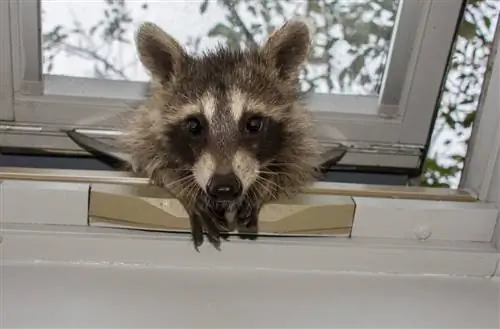
Open skylights are an invitation for raccoons
Make sure that the raccoon cannot find any means of access. The small bears are climbing artists and can reach the roof via gutters, trees, pillars or corners of houses. Walls with rough plaster, clinker tiles or bricks offer the animals optimal support for climbing.
How to prepare trees:
- Short the branches so that the distance to the house is at least one meter
- cut lower branches that hang less than a meter above the ground
- Attach a 60 centimeter long sleeve at a height of 60 centimeters around the trunk
Metal plates with a smooth surface and a height of 100 centimeters are recommended for rain pipes, walls and columns. In contrast to wire frames, they interrupt the climbing paths. Barbed wire often acts as an additional climbing aid. Alternatively, you can install special electric fence systems along the gutters. As soon as a raccoon tries to pull itself up, it will receive a nasty electric shock.
Tip
Raccoons find refuge in the forks of branches, tree hollows or in abandoned badger and fox dens. Search sheds, garden sheds and granaries to spot the animals.
Prevent food sources
Compost heaps should be covered so that raccoons cannot gain access. A fully enclosed container is more suitable than a frame made of fine-mesh wire with a tarp. Do not leave rubbish bags outside, but rather deposit them in the garden shed, garage or storage room. Avoid bird feeding stations. Even squirrel feeders with a folding mechanism are no obstacle for raccoons.
Secure the beds:
- Install bird protection net
- weighing it down with stones
- Fighting snails
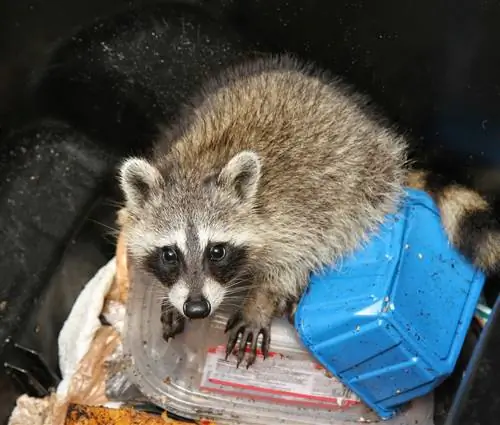
Garbage cans are a great source of food for hungry raccoons
Garbage bins can be secured with stretched rubber bands or weighted with stones. However, raccoons prove to be capable of learning and will eventually overcome such obstacles. In Kassel, garbage cans have been fitted with locks for a long time. Fruit trees and bushes should be harvested early.
Tip
Raccoons are omnivores and base their diet on seasonal offerings. Make sure there are no nuts, fruits, meat and vegetable scraps in your garden. Cover garden ponds with fish, because they will also be robbed.
How to recognize raccoon tracks
Eaten plants in the bed, fallen flower pots and torn chair cushions are not a clear indication of the activity of raccoons. Spread a trail of sand around potential feeding sites, beds and compost piles. The next day, check whether there are any paw prints left in the sand.
Identify paw prints:
- Toes very long and finger-like
- often spread apart
- connected to the metacarpal ball
- Heel of the metacarpal has the indistinct shape of a sole
- Front paws hand-shaped

Frequently asked questions
What attracts guard bears?
Mammals are omnivores. They prefer easy-to-prey food, which is why they are becoming more and more common in populated areas. Suburban fruit and nut trees provide a welcome source of food. Public trash cans or garbage cans and compost heaps on private property are attractive. Undisturbed attics are an ideal place to retreat, overwinter and raise young.
What do raccoons do during the day?
Raccoons are active at dusk and at night, so they spend the day in niches that are difficult to access. In nature, tree and earth caves or rock crevices and abandoned buildings provide an ideal place to retreat. In contrast, the small bears in residential areas use abandoned buildings, stables and barns to rest. Garages, basements, attics and sewage systems are also visited.
Raccoons in winter:
- look for protected hiding places
- keep hibernating and draw on fat deposits
- become active immediately on warmer days
What damage can raccoons do?

Raccoons can cause considerable damage, especially to roof insulation
43 percent of climbing artists prefer buildings as a place to retreat, while 39 percent prefer tree hollows. Young raccoons between the ages of eight and ten weeks are particularly curious and explore their surroundings very thoroughly. It is not uncommon for the play instinct to come through, so that the animals can destroy the entire attic insulation.
Urine and feces not only cause unpleasant odors, but can also be a breeding ground for pathogens. Consequential damage is not uncommon if displaced roof tiles and metal sheets remain undetected.
Danger to nature
- root nests of cave-nesting birds
- can bats be dangerous
- endanger populations of sea eagles or eagle owls
How do raccoons eat?
The animals are predators and use their front paws to search for food. They prefer animal food in spring to replenish their fat reserves, which they have lost in winter. Earthworms, insects and snails as well as young birds and mice make up the majority of their diet.
During the summer and autumn months, the animals switch to plant food and collect seeds and fruits. In the winter months they rely on their fat stores and seek out waters that are not frozen over on warmer days. Raccoons need 200 to 400 grams of food per day.
Can raccoons transmit diseases?
Investigations into the raccoon population in Hesse showed that around three quarters of the animals carried the raccoon roundworm. This parasite could not be detected in animals in Brandenburg and the Harz Mountains. Therefore, there is an increased risk of people becoming infected with roundworms, mainly in the region around Kassel.
There are only a few raccoons that have been diagnosed with rabies. Diseased animals showed passive and disinterested behavior. They usually retreat to well-protected hiding places in order to die undisturbed. Curious raccoons looking for food are generally not suspected of having rabies. They can bite if they feel threatened.

